TrustRadius 2021 Women in Tech Report
Women in tech are facing historic challenges in 2021.
We’ve now spent a full year under pandemic conditions in an industry marked by upheaval. We find ourselves at a crossroads, where progress toward gender equality is threatened by a crisis that disproportionately impacts women.
The fight for gender equality continues to be crucial, especially with this setback.
The third annual TrustRadius Women in Tech Report offers insight into these issues.
We surveyed over 450 tech professionals (66% who identified as women). In their words, we discovered the biggest challenges women in tech face in 2021. We also heard their suggestions for what can be done to fix them.
Top 9 Takeaways from the Women in Tech Report:
![]() COVID-19 severely impacted women in tech
COVID-19 severely impacted women in tech
![]() Women in tech carry even more household work now
Women in tech carry even more household work now
![]() Women in tech are divided on the impact of remote work
Women in tech are divided on the impact of remote work
![]() “Bro culture” is still pervasive according to women in tech
“Bro culture” is still pervasive according to women in tech
![]() Women are still outnumbered in the tech industry
Women are still outnumbered in the tech industry
![]() Women in tech have to work harder to prove their worth
Women in tech have to work harder to prove their worth
![]() Women face more barriers to promotion in tech
Women face more barriers to promotion in tech
It’s time to take a stand for women in tech.
Research like this is crucial for raising awareness and inspiring real change. Please share this report with your coworkers and leaders in your network.
Below you’ll find a free slide deck with all the new data from this year. Feel free to download this deck and share some insights in your next company meeting.
New Women in Tech Statistics For 2021
- 57% of women in tech feel burned out at work this year, compared to 36% of men.
- Women in tech are nearly twice as likely as men to have lost their jobs or been furloughed due to the pandemic.
- Women are divided on whether remote work has helped or hurt women in tech. 42% say it’s had a negative impact, 41% say the impact has been positive, and 17% say there’s been no impact.
- 72% of women in tech have worked at a company where bro culture is pervasive. That average includes 83% of women in sales, 80% of women in marketing, and 63% of women in IT/engineering.
- The majority (72%) of women in tech are regularly outnumbered by men in business meetings by at least a 2:1 ratio. 26% of women report being outnumbered by 5:1 or more.
- 78% of women in tech feel they have to work harder than their coworkers to prove their worth.
- Women in tech are 4X more likely than men to see gender bias as an obstacle to promotion. 39% of women see gender bias as a barrier to promotion in 2021.
- Women of color are less confident than white women about their promotion prospects—and that gap has increased by 3X over the past year.
- 37% of women of color in tech feel that racial bias is a barrier to promotion.
- To help support women in tech, 78% of women say companies should promote more women into leadership positions. Other solutions include:
- Providing mentorship opportunities (72%)
- Offering flexible scheduling (64%)
- Conducting unconscious bias training (57%)
- Offering equal maternity and paternity leave (55%)
1. COVID-19 Severely Impacted Women in Tech
New research from TrustRadius shows that women in tech have been impacted significantly by the COVID-19 pandemic. In terms of burnout, they’re facing more of the negative impacts of this crisis than their male peers.
57% of the women we surveyed feel more burned out at work due to the pandemic. In comparison, only 36% of men feel the same. We did not receive a large enough sample size of non-binary survey respondents to report.
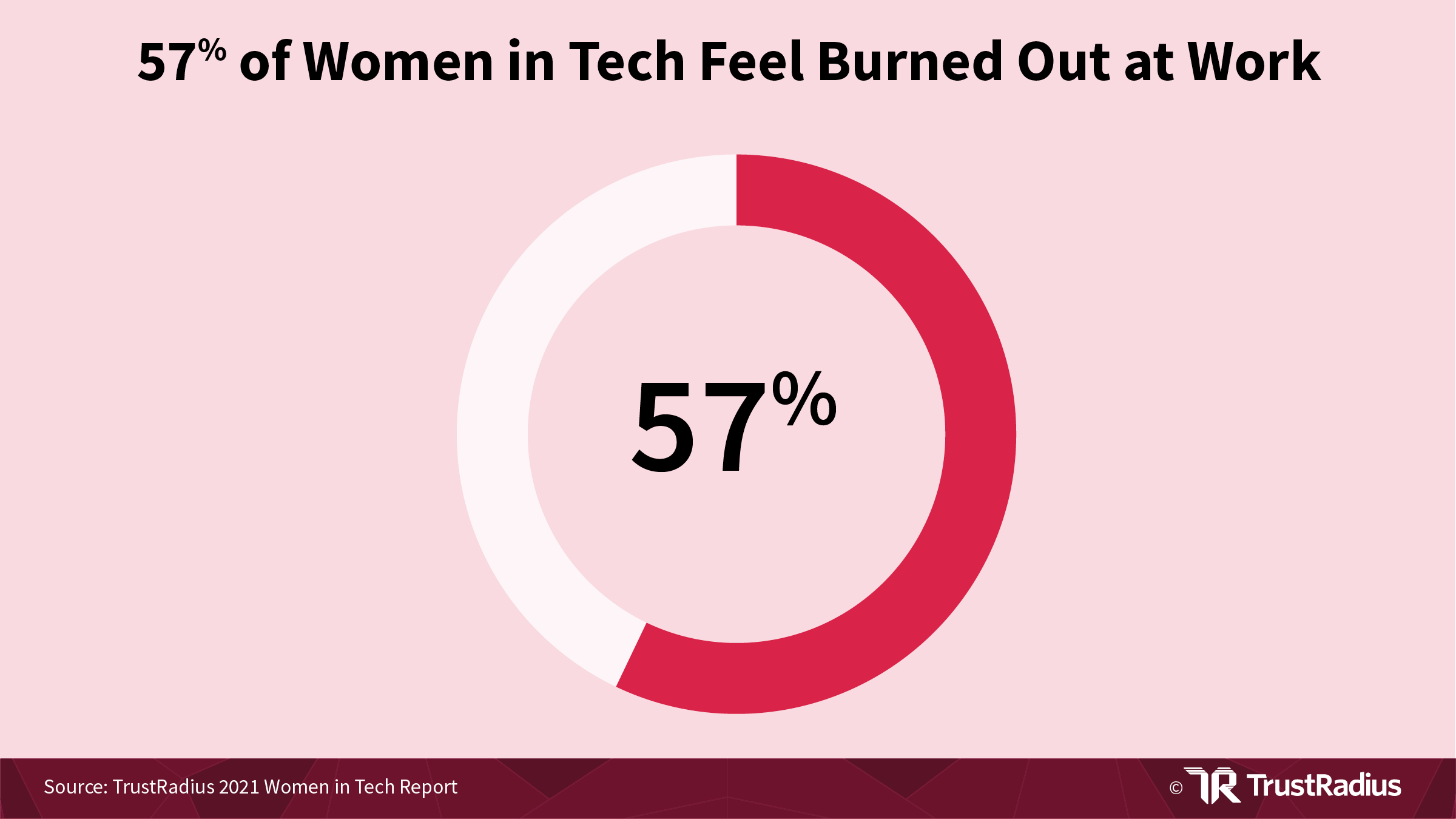
The inequalities don’t stop there. 43% of the women we surveyed have taken on extra responsibilities at work, compared to only 33% of men. A greater proportion of women have taken on a greater childcare burden—29% of women, compared to 19% of men.
We also learned that women in tech are twice as likely as men to have lost their jobs or been furloughed due to the pandemic.
The New York Times explored this trend. They found that 1.2 million American parents have had to exit the workforce in the past year. 900,000 were women—meaning women are three times as likely as men to have left the workforce.
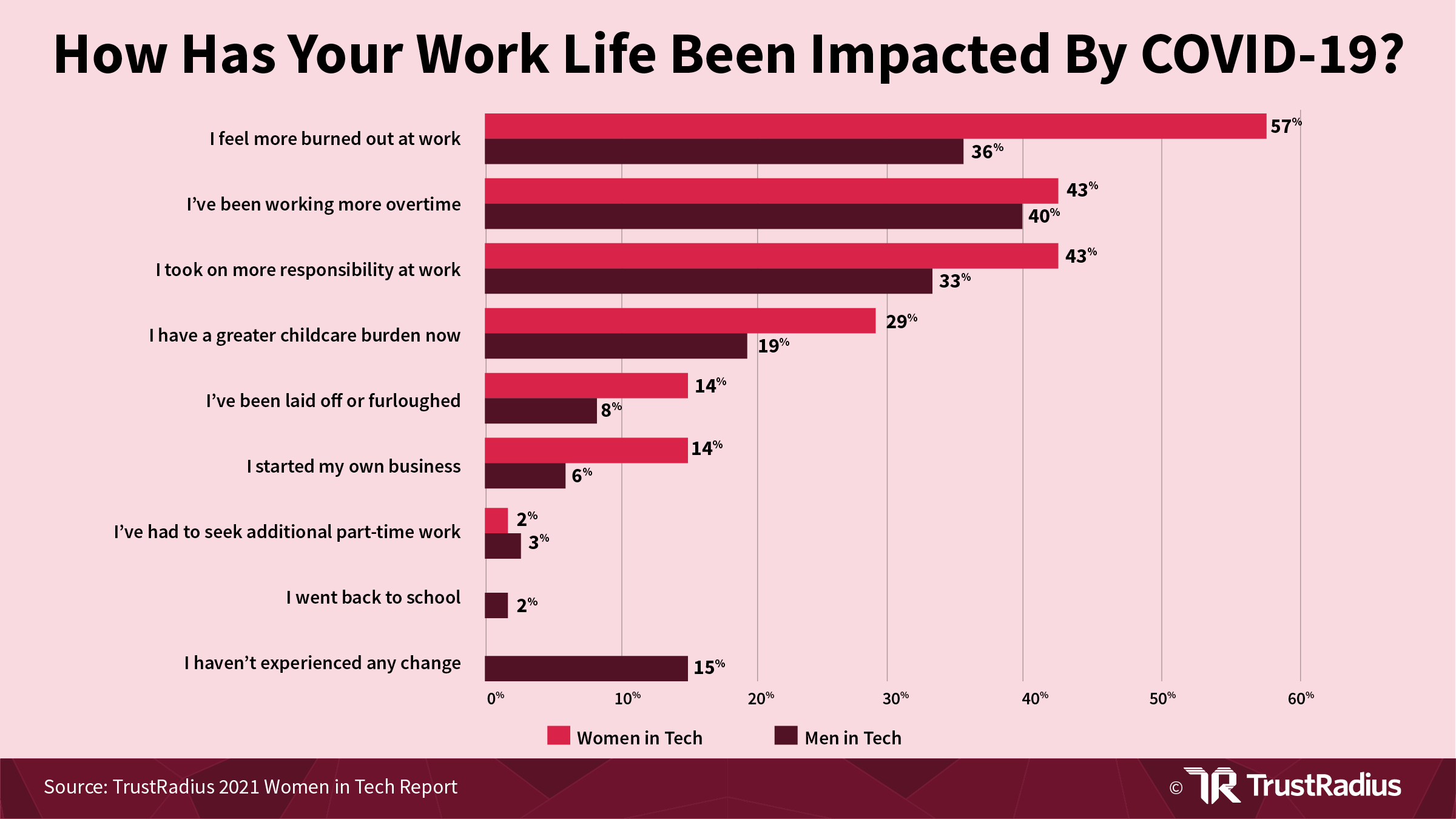
When we surveyed our community back in June 2020, 85% of tech professionals felt that their companies had done a good job of handling the pandemic. But we now see that some of the tradeoffs companies made had a bigger impact on women.
The inequalities women face are industry-wide. We can’t place blame on specific companies, because this issue is much broader in scale. In fact, it’s not just an industry issue. It’s an issue with the holistic way women are impacted by responsibilities at work and at home.
2. Women in Tech Carry Even More Household Work Now
Inequality rarely exists in a vacuum. Our research shows that the inequality women experience at work is compounded by the inequality they often face at home.
Sociologist Arlie Russell Hochschild pioneered the term “second shift” to describe the historical housework burden that women carry in addition to their normal work hours. In the past year, exacerbated by the pandemic, that second shift got longer for women around the world.
42% of women in tech say they took on most of the household work during the pandemic, compared to only 11% of men. Men in the tech industry were far more likely to have their partners take on the majority of household work or to share it evenly.
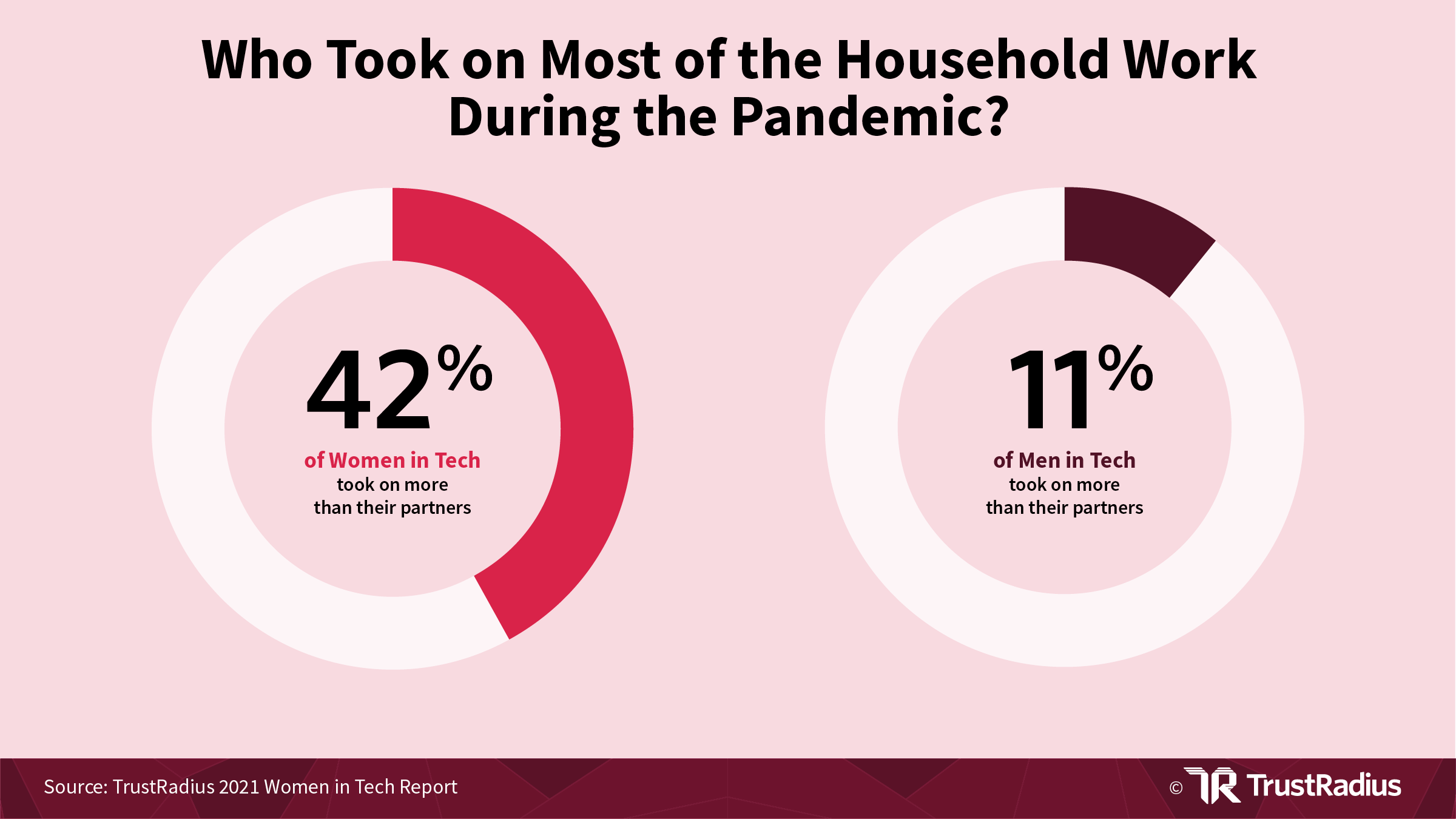
As you can see, women are almost three times as likely to shoulder most of the household work during the pandemic. The men we surveyed recognized this pattern too. A large percentage of men in tech admitted that their partner or co-parent took on more household labor during this time.
That said, COVID-19 doesn’t appear to have radically shifted the division of household work for the majority of respondents. 53% of tech workers say that the balance of household work hasn’t shifted in their homes.
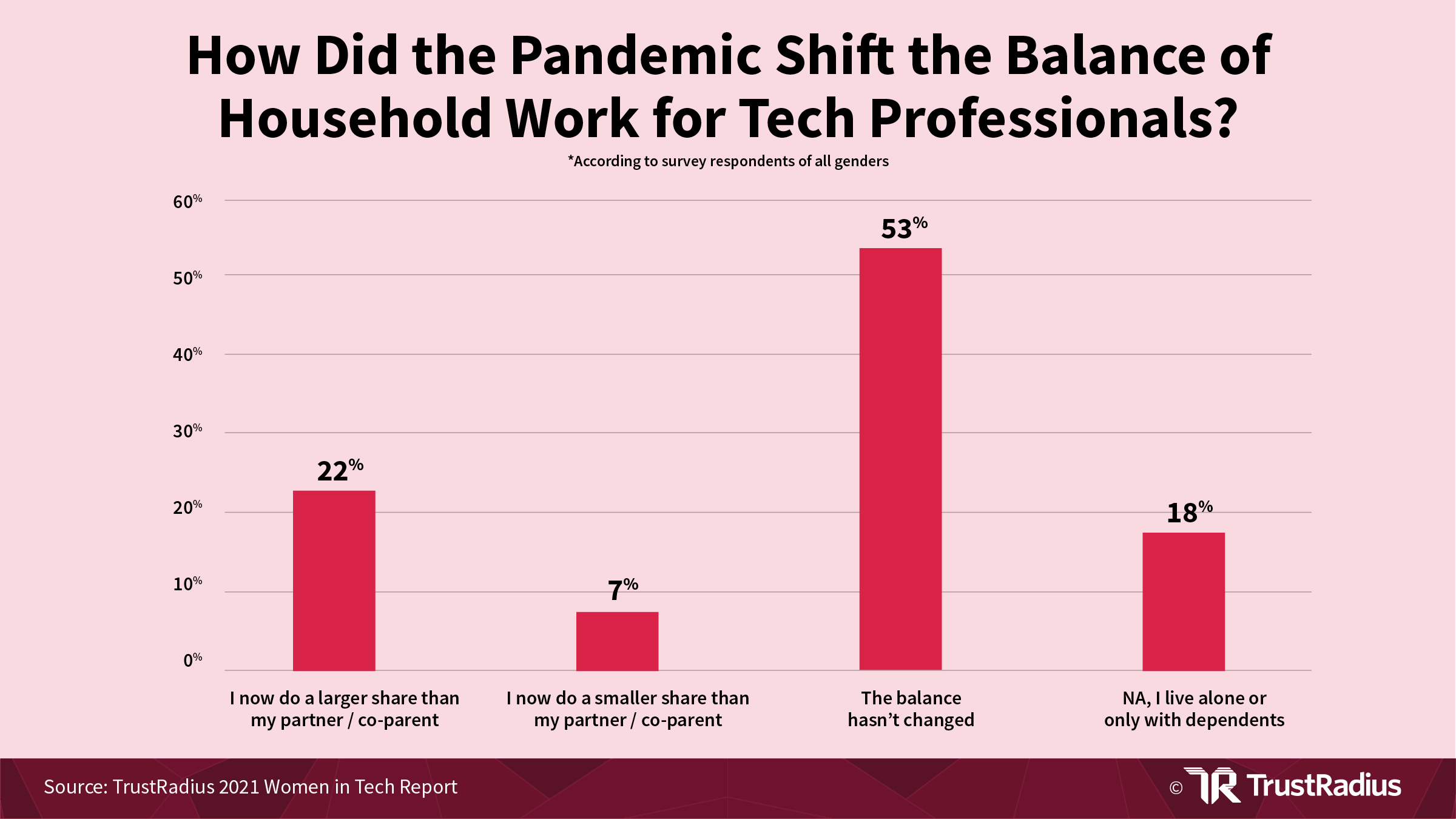
About 1 in 5 tech professionals has taken on a larger share of household work. Far fewer have offloaded their share of work to a partner or co-parent.
Jobs in the tech industry can be quite demanding. But tech positions often offer flexible scheduling and the ability to work from home. This may make it easier for tech professionals to take on household work compared to those in healthcare, construction, or retail. It’s stressful to take a Zoom meeting with a child on your lap, but it’s possible.
The COVID-19 pandemic increased the amount of work needed at home. Since women already did the vast majority of that work, they now face a greater burden. There’s more work to be done, and women are doing more of it.
3. How Has Remote Work Impacted Women in Tech?
In a previous study, TrustRadius found that many tech workers feel more productive working from home. 57% of tech professionals said they were more productive, and only 17% felt less productive.
We wanted to dig deeper and see how this change affects women in our industry. Does working remotely give women a more equal footing at tech companies? Or does it limit their opportunities in some way?
When we asked if remote working has helped or hindered women in tech, women were evenly split. On the other hand, men are twice as likely to believe remote working has had a positive impact on women.
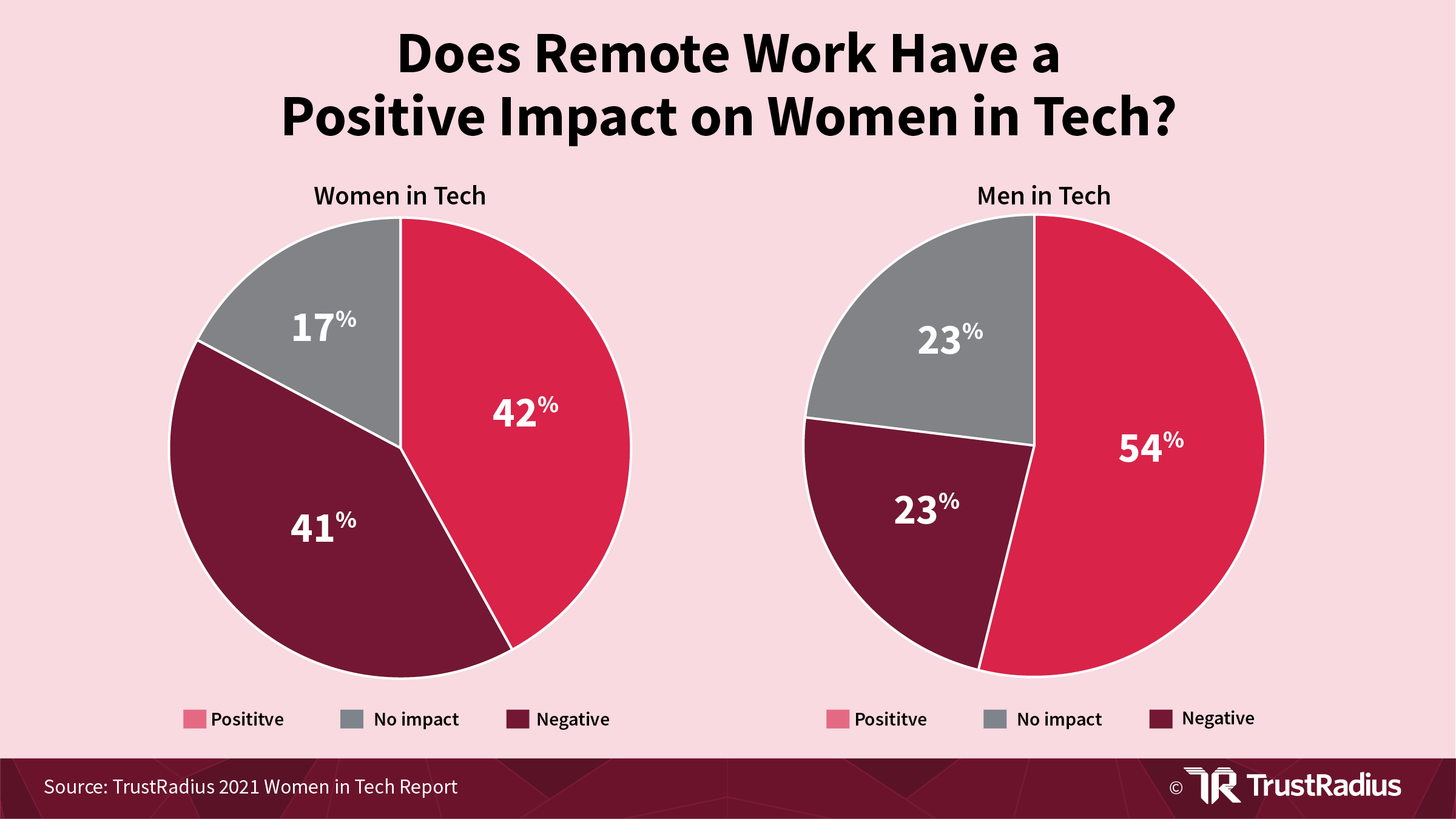
Why are women so divided on this issue?
One survey respondent thinks that depends on who cares for children at home:
“I think Covid 19 has put a new spotlight on the workload for working parents, but especially working mothers, because they are expected to take care of the kids and their jobs. I think the best thing to come out of the last year is the awareness this has created and the flexibility and understanding it has offered to allow people to be parents, mothers and then workers.”
—Anonymous, Individual Contributor in Customer Service
Women in different departments have also had very different work-from-home experiences.
53% of women in Engineering and IT say that remote work has been positive for women in tech. But that percentage decreases across women in Sales, Marketing, and Customer Service.
This could be due to the fact that these fields are more incentive-based and competitive. Traits like assertiveness, confidence, and ambition are crucial here. We know that these traits are often seen as negatives in women and positives in men. It’s possible that remote work may be amplifying sexist trends that already exist.
These fields are also more metrics-based. There’s a clear, numbers-based way to measure success in these roles. It may not matter as much whether employees are communicating remotely or in-person. Other demands on their time may be a bigger factor.
Women in tech have to manage a greater amount of household work, which limits the energy they can put into hitting those numbers. The deteriorating boundary between work and home can mean working overtime at both.
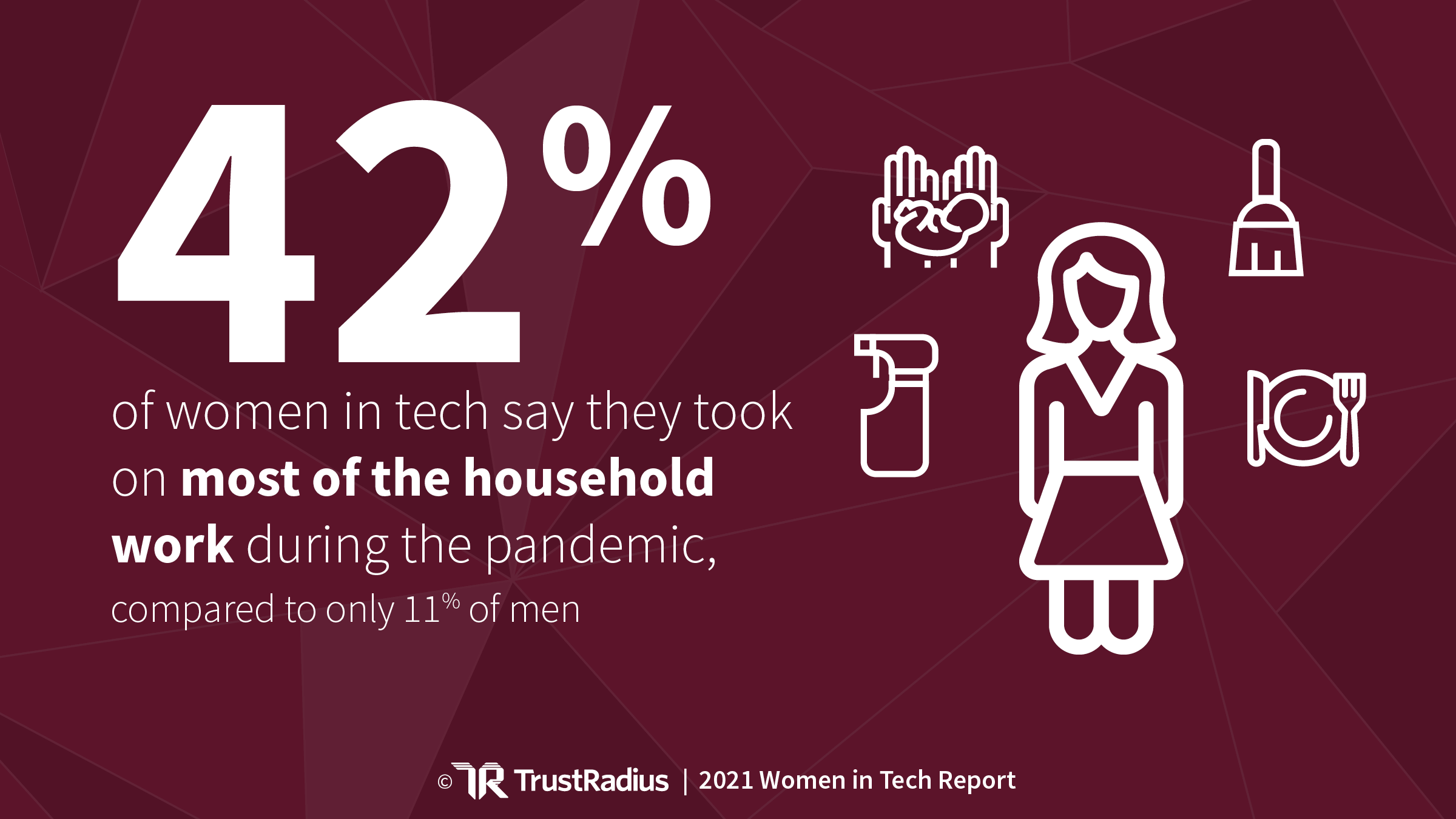
Seniority also has an impact on how people perceive remote work. We found that men in leadership positions are more likely to see the shift to remote work as a positive for women in tech. Women in leadership positions are more likely to see a negative impact.
This may be due to an increased focus on results, which could be viewed by male leadership as equalizing the playing field. Women in leadership positions may experience the pandemic overload firsthand and may have a different view.
4. Women in Tech Still Face Pervasive “Bro Culture”
72% of women in tech have worked at a company where “bro culture” is pervasive. This is about the same as last year when 71% of women reported experiencing bro culture.
Only 41% of men say the same. This indicates that the discrepancy is due to a difference in perception. It can be hard for those in power, or those not negatively affected, to recognize problems within the dominant culture.
It’s worth noting that bro culture manifests in a lot of different ways across the tech industry. It can range from an uncomfortable work environment to sexual harassment and assault. Men and women perceive that culture very differently.
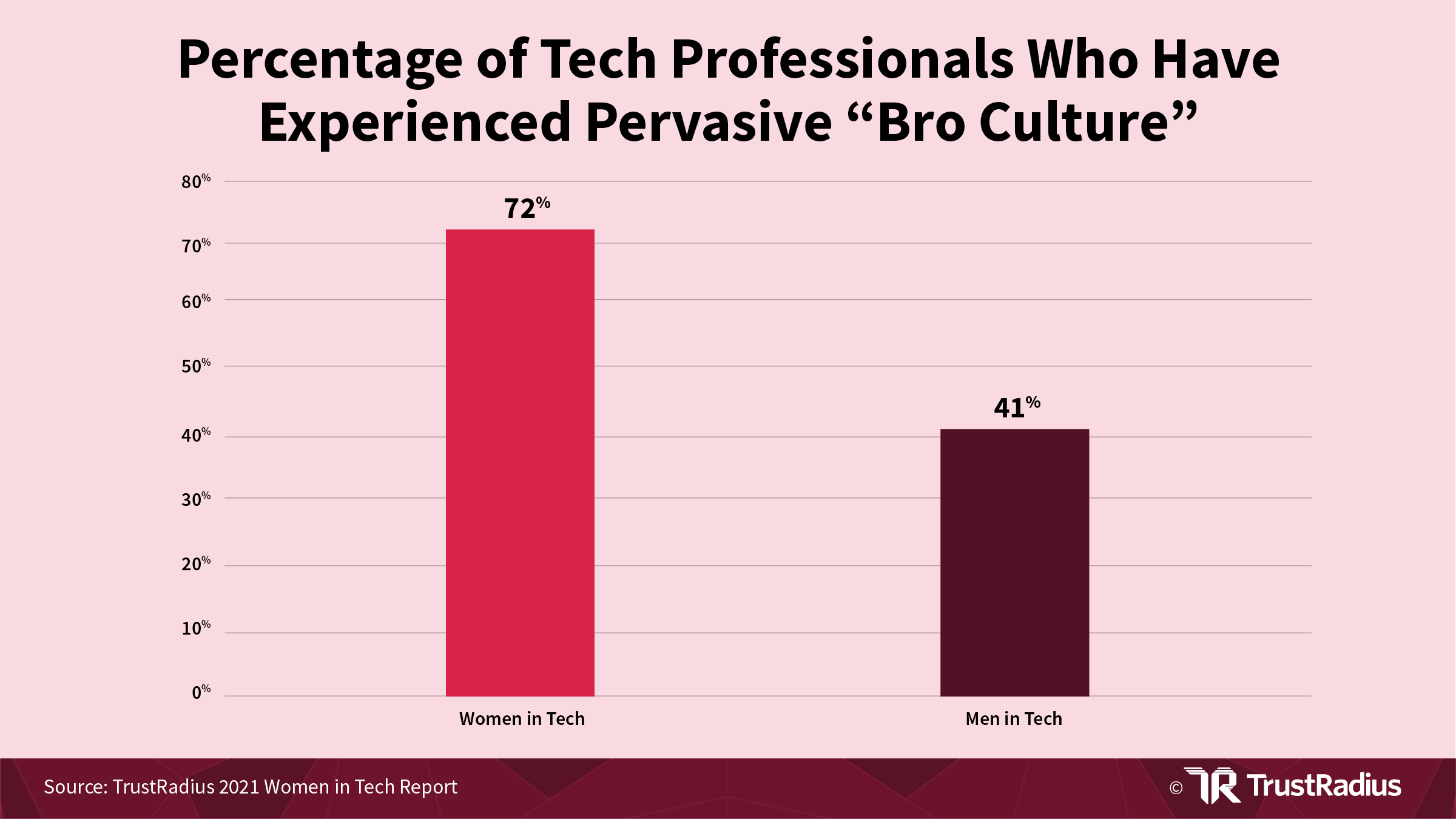
We also found that the pervasiveness of bro culture varies by department. 83% of women in Sales and 80% of women in Marketing experience this issue in 2021.
In comparison, 63% of women in Engineering and IT have experienced pervasive bro culture. This is considerably less than in other departments, but still far too high.
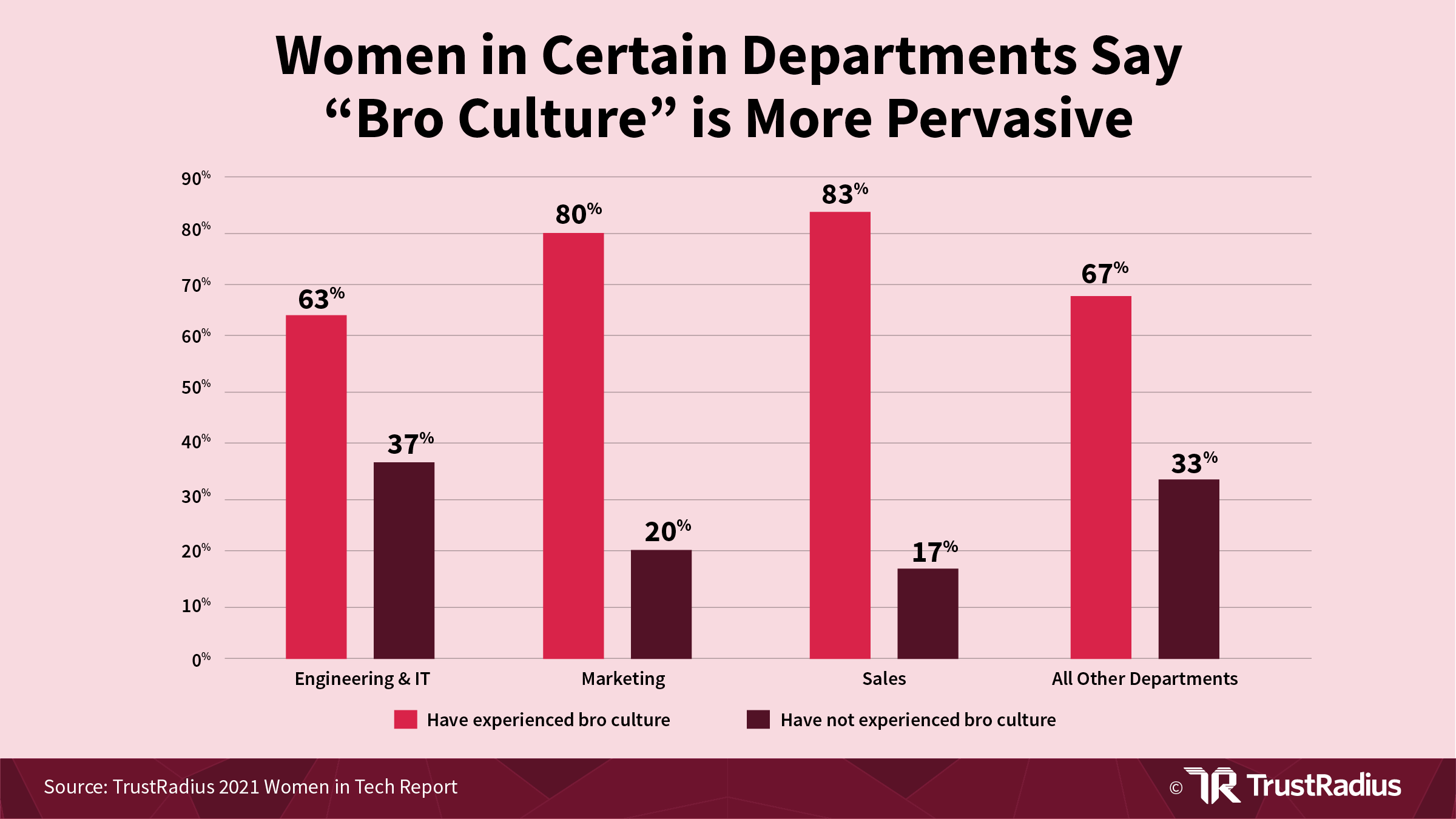
While the differences were slight, we also discovered an age-related trend here. Our data indicates that Millennial and Gen Z women may be less likely to have experienced bro culture than older women. This could be a sign of genuine progress in the last decade.
The other explanation is that Boomer and Gen X women have simply worked more jobs. This means more chances to experience sexist workplace culture. We hope to see those Gen Z and Millennial numbers stay the same in the future, even as these professionals progress in their careers.
5. Women Are Still Outnumbered in the Tech Industry
While we’ve seen some progress toward gender equality in the tech industry over the past decade, women are still vastly outnumbered by men.
In 2021, 72% of women in tech are outnumbered by men in business meetings by at least a 2:1 ratio. The vast majority of men agree with this observation.
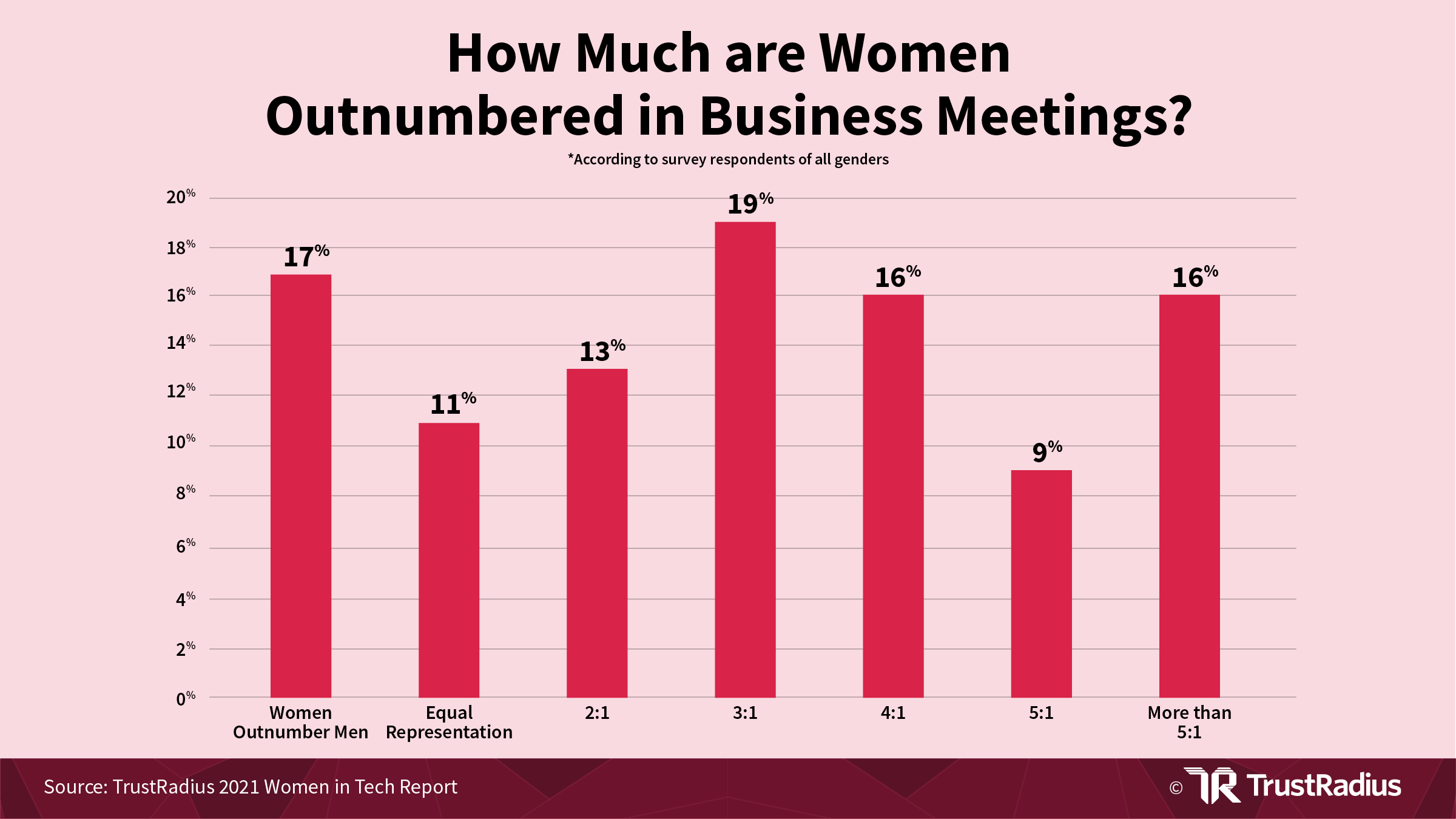
Many women experience an even greater discrepancy. 26% of women report being outnumbered by 5:1 or more in most meetings.
This lines up with self-reported research from the largest tech companies in America. There, female employees make up between 28% (Microsoft) and 42% (Amazon) of the total workforce.
Having so few women at the table leads to the silencing of women. The science is clear—men tend to interrupt women far more than men interrupt men or women interrupt men. As a result, the women who are in the meeting are less likely to be heard.
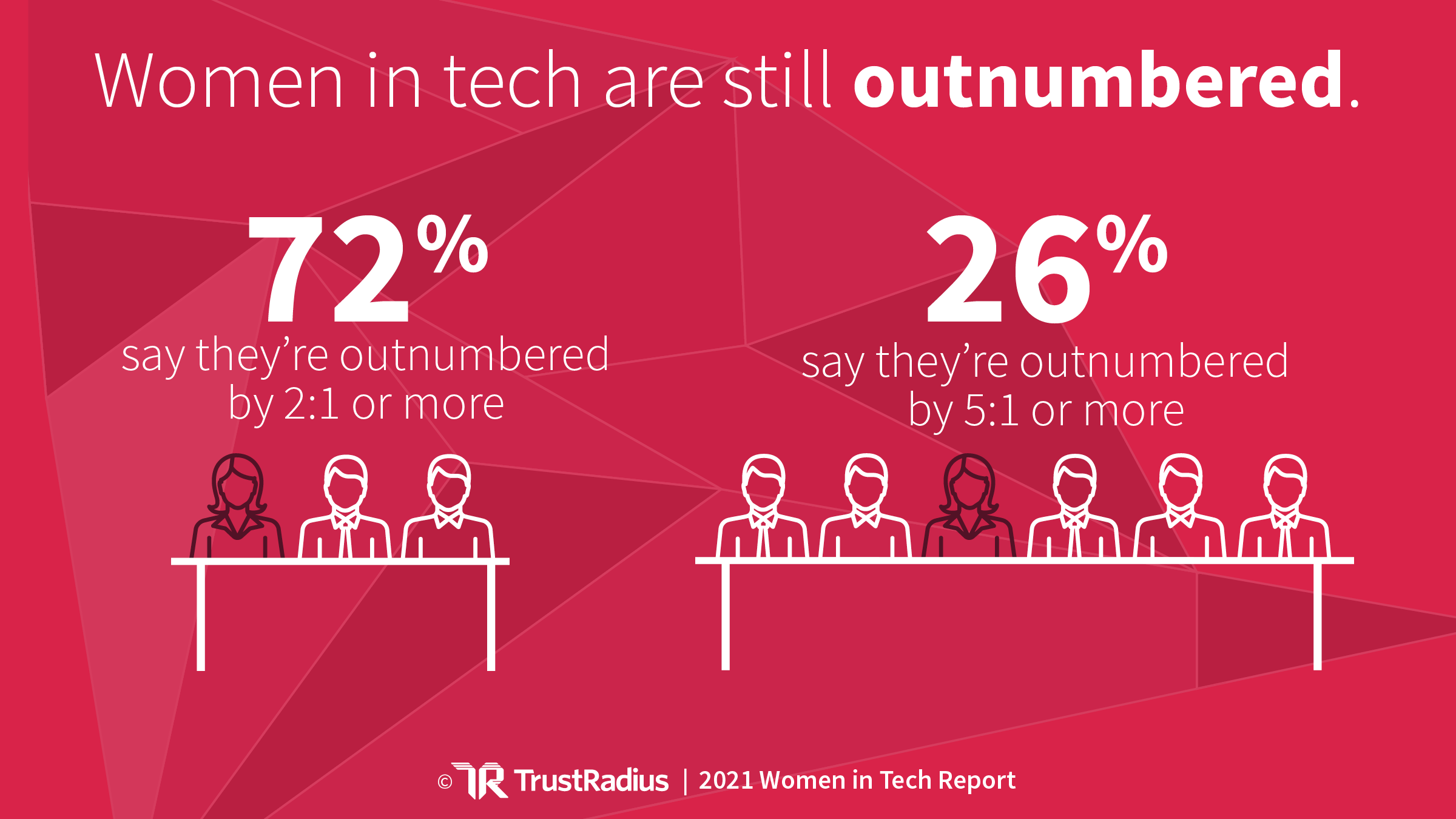
Lack of representation leads to other challenges for women in tech as well. It limits their opportunities for mentorship and sponsorship. It fosters unconscious gender bias in company culture. And it leaves many women without a clear path forward. Underrepresentation underlies many of the inequalities covered in this report.
6. Women in Tech Have to Work Harder to Prove Their Worth
In 2021 we learned that women are more likely than men to feel that they have to work harder than their coworkers to prove their worth.
Our research shows that 78% of women feel like they have to work harder to prove their worth at work. Only 54% of men say the same.
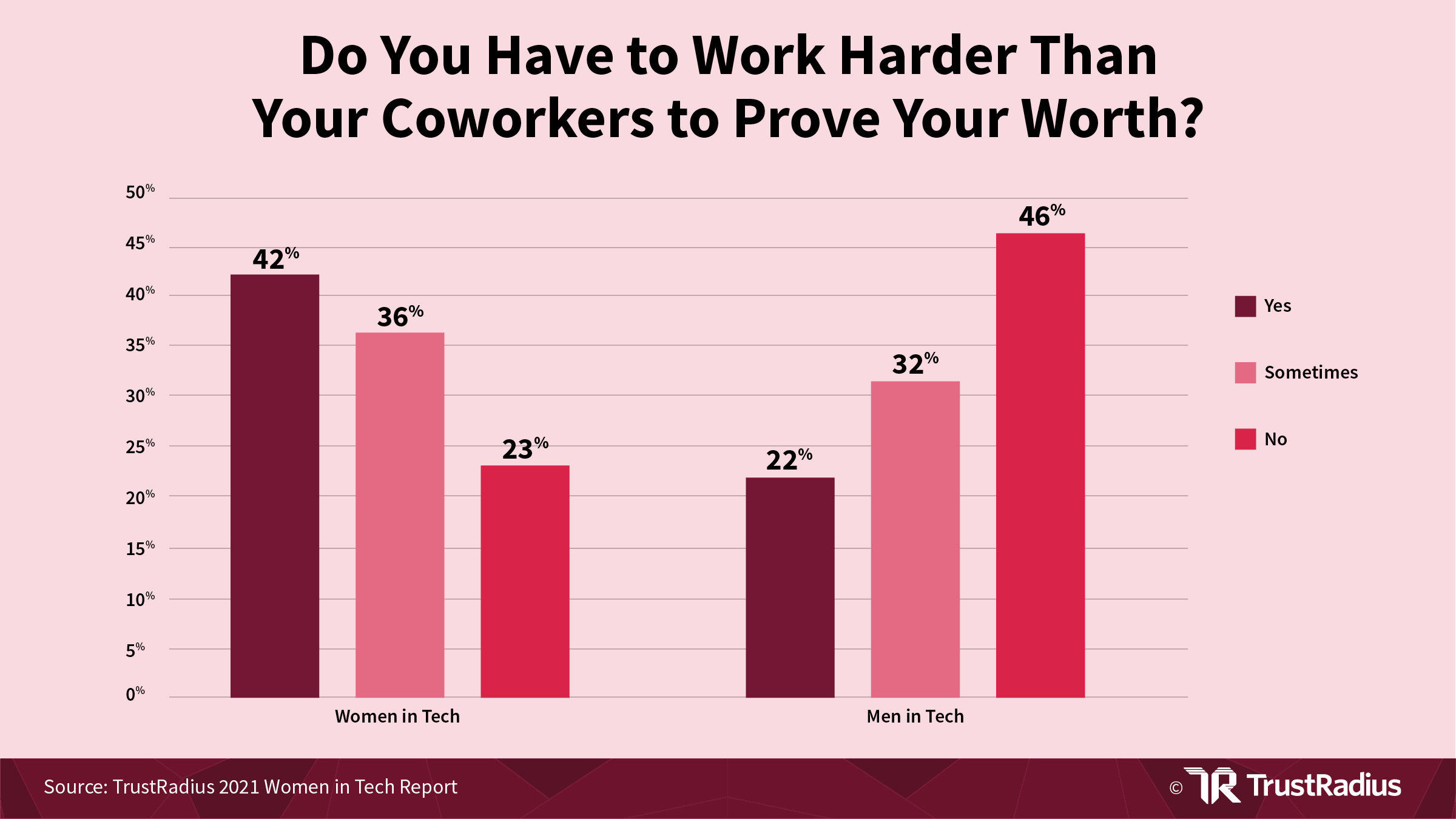
Across all job levels, women feel more pressure to prove themselves. But the phenomenon is even more pronounced among those in leadership positions. Women who are VPs, C-level, or CEOs are especially likely to feel this pressure. For men, the opposite is true.
This aligns with last year’s Women in Tech research. We found that women were 22% more likely than men to experience imposter syndrome at work. Imposter syndrome is the feeling of being underqualified and out of place compared to your colleagues. As a result, some women put in extra work or extra hours to compensate.
There’s another way to look at the relationship between imposter syndrome and needing to prove your worth. Even women who are perfectly confident in their abilities can experience the pressure to outperform their male coworkers in order to earn equal recognition and opportunities.
Here’s how one survey respondent feels about this issue:
“Virtually everything a man does, a woman does too. Give more opportunities and believe in their potential. Offer more leadership positions to make it clear that a woman is also very capable of leading teams”
—Sandro Roberto Lima Santos, Auxiliar Administrativo at ACOPAMEC
Lack of trust in their abilities from managers and executives—and seeing no clear path forward—are major concerns for women struggling to grow their careers in the tech industry.
7. Women Face More Barriers to Promotion in Tech
We know that only 25.1% of executive or senior-level officials and managers at S&P 500 companies are women. Only 4.6% of those companies have women CEOs.
Women in tech see plenty of reasons for this difference. Barriers to promotion are a major contributing factor. This is known as the “broken rung” phenomenon—a missing step on the career ladder for women on the way to leadership.
In 2021, women in tech are four times more likely than men to see gender bias as an obstacle to promotion. Nearly 2 in 5 women felt that their gender was a barrier to being considered for their next promotion.
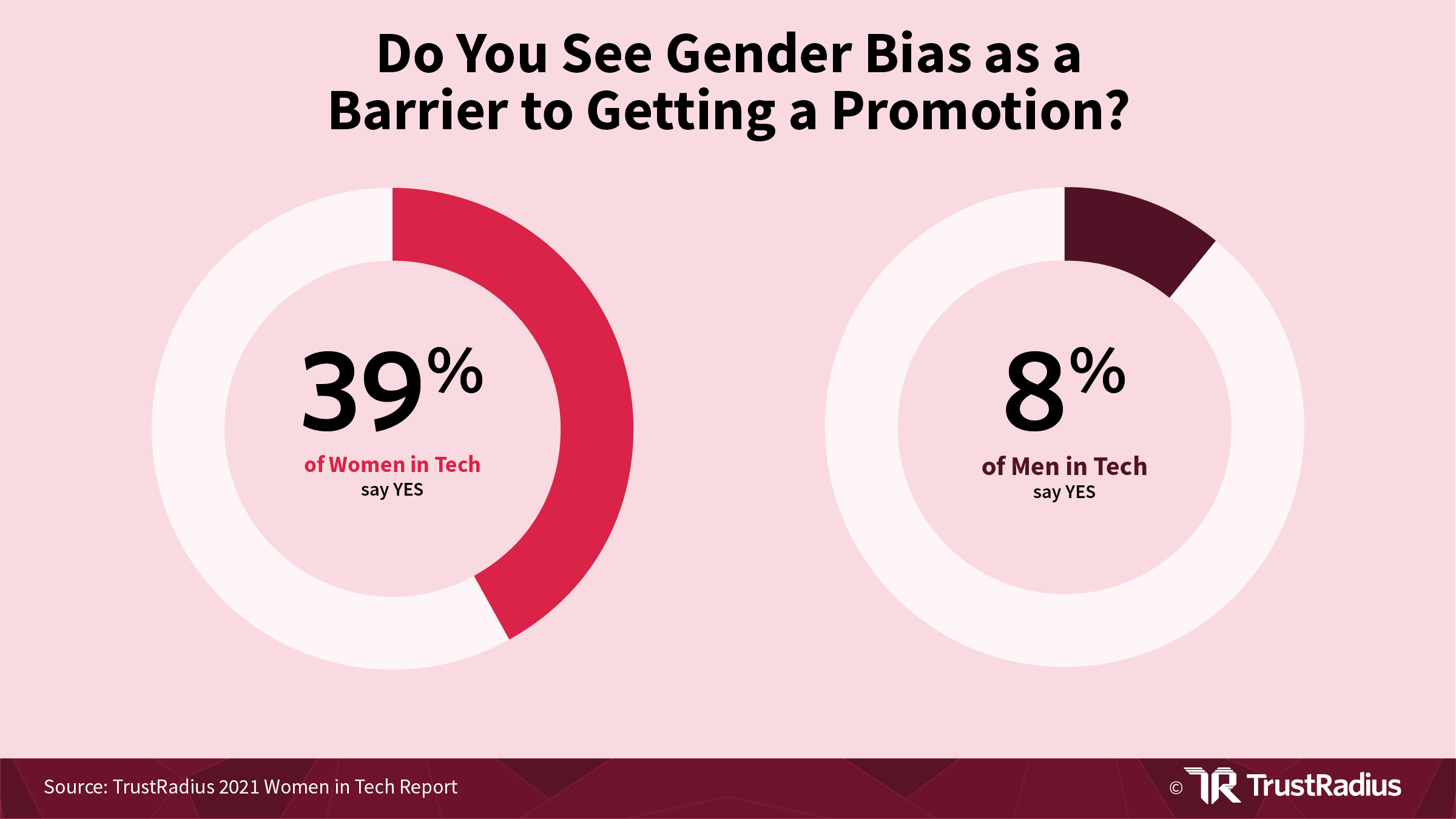
We also discovered several other issues that women in tech face when it comes to promotion:
- 66% of women felt there was no clear path forward for them at their current company
- 41% identified the lack of a mentor as an obstacle to promotion
- 39% cited limited budget as a major problem
- 29% of women felt there was a lack of trust in their ability
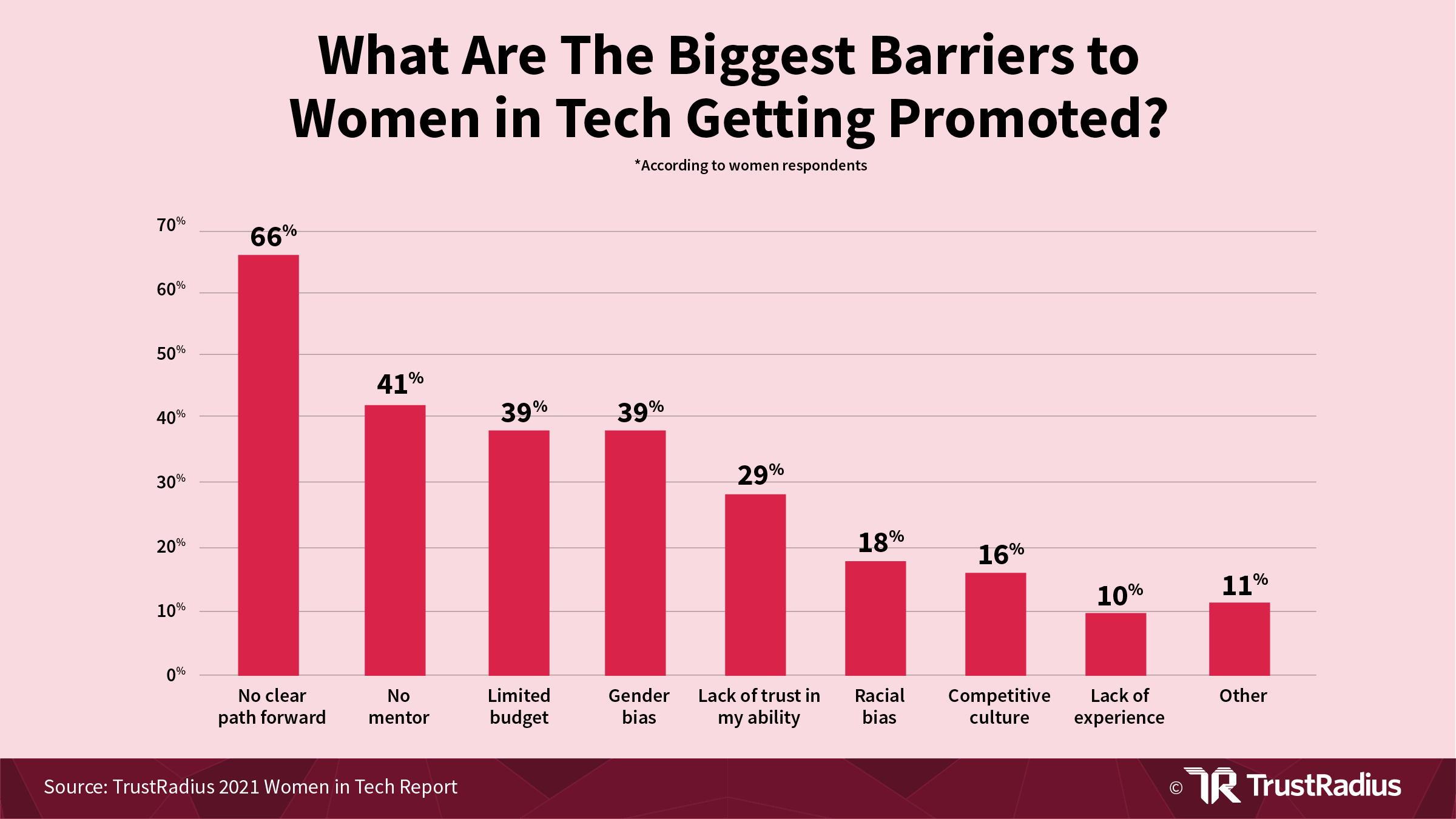
Note: This graph represents women who feel either ‘not at all confident’ or ‘a little bit confident’ that they will get promoted in the next two years. In total, this amounts to 114 respondents.
Another sobering finding is that among respondents who identify as Asian, Latino, Black, American Indian, Pacific Islander, or “Other,” nearly 2 in 5 women (37%) see their race as a barrier to getting promoted. Women of color are also more likely than their white peers to identify gender bias, lack of trust, and budget issues as obstacles.
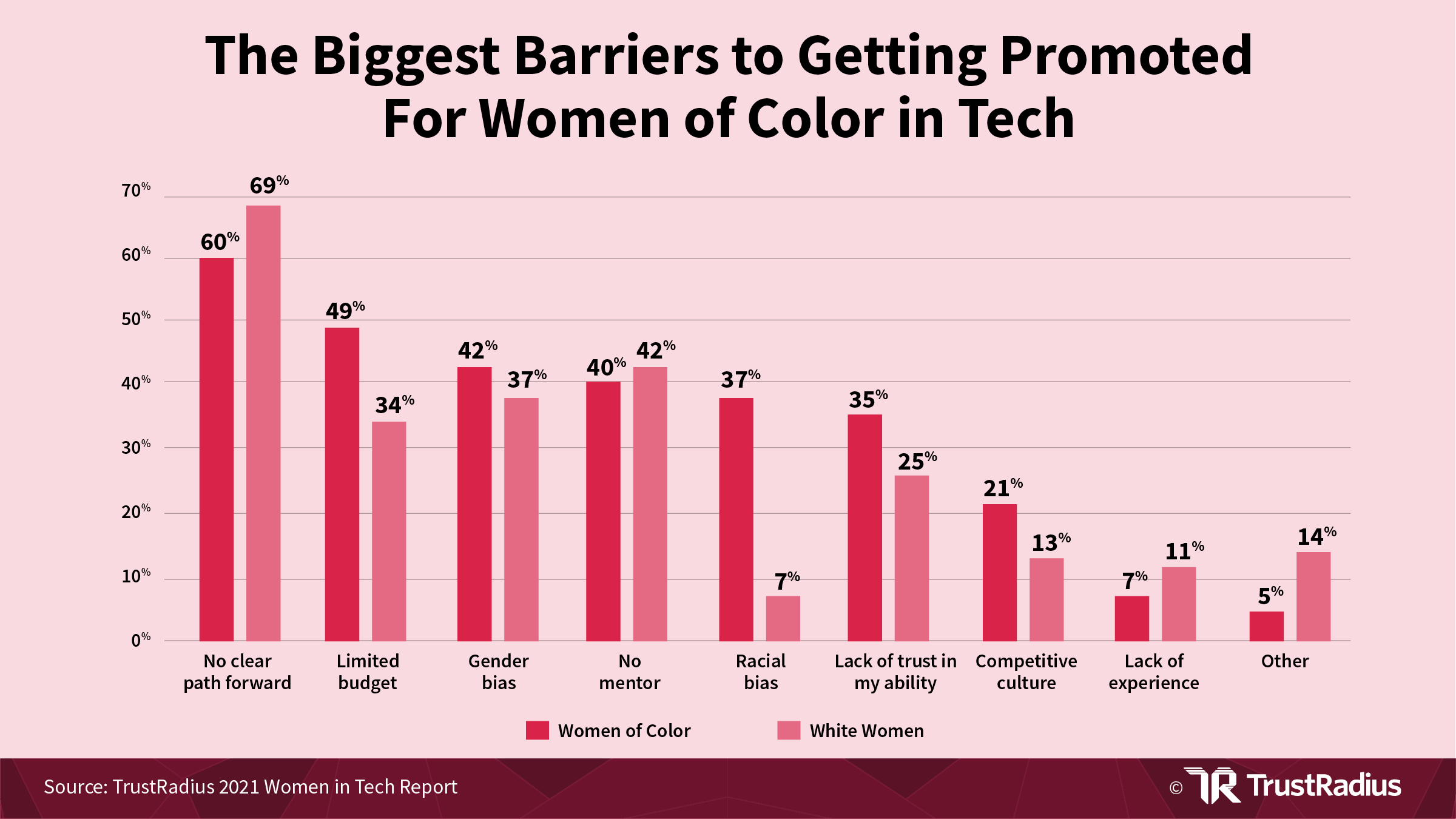
Despite these realities, our data shows an inspiring truth. 62% of all women respondents feel confident that they will earn a promotion within the next two years. This is identical to last year’s findings. Men report similar levels of confidence in earning a promotion.
Any positivity is undercut by the racial divide in this question. Women of color are 27% less confident in their promotion prospects than white women. This is nearly 3X the difference from last year when women of color felt 10% less confident.
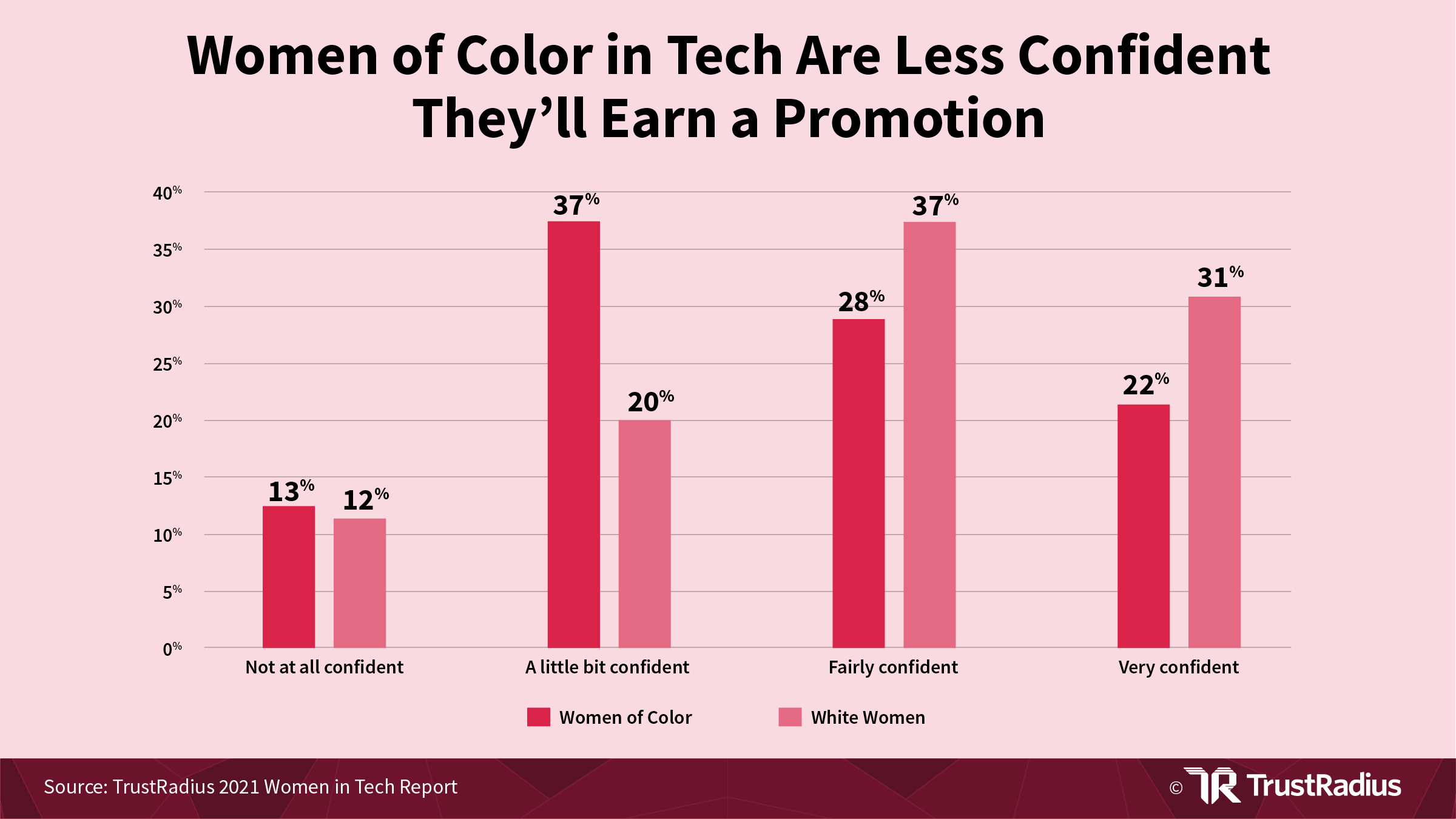
Another important note: Of the women of color who doubt their promotion prospects, 35% say that it’s because their companies don’t trust their abilities.
Many people of color have experienced this kind of discouraging environment—where every task is second-guessed and building trust feels impossible. This is what happens when tech companies try to pursue diversity without inclusion.
These findings highlight the importance of looking at gender equality in the workplace through an intersectional lens. They also show that the challenges of this year have caused unequal impacts along racial lines.
8. Gender Equality Hasn’t Changed in the Past Year
Unfortunately, in a year of crisis, we have not seen much progress to greater equality. More than half of both men and women said gender equality stayed the same in their workplaces.
Some women are seeing backsliding, perhaps as a direct result of the pandemic. Women are 2X more likely than men to say gender inequality got worse at their company in 2020.
The status quo is unequal and unacceptable, and some did see progress in 2020. 41% of men say gender equality has improved in their workplace. Women are decidedly less favorable in their outlook, with just 28% saying things have improved.
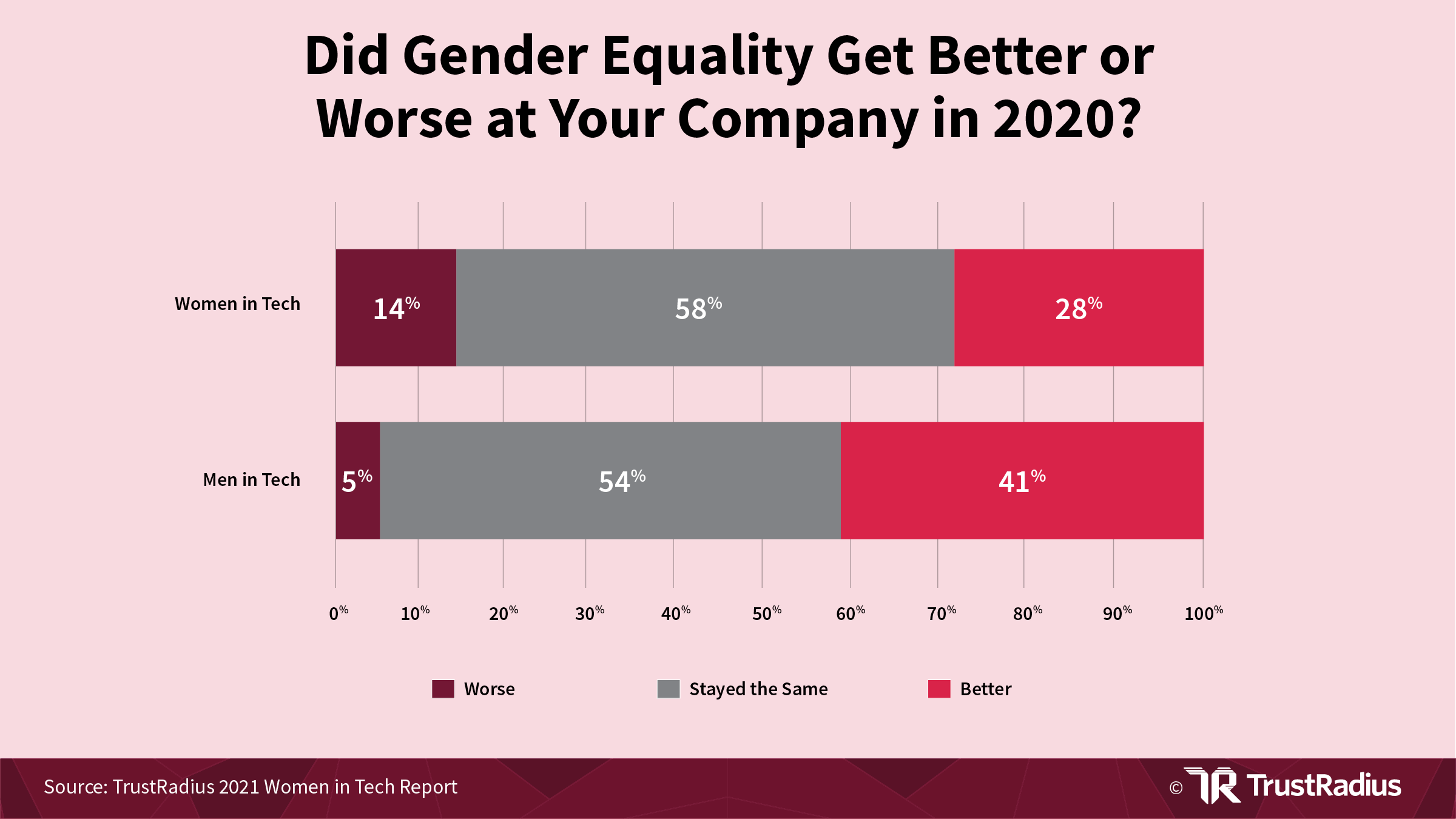
While holding steady against new challenges could be seen as a form of progress, it’s not enough. We must continue to address the challenges that impact women unequally.
Leadership positions are still problematically male-dominated. We were concerned to see that those in leadership felt even more doubtful of progress. Across men and women, only 24% of executives felt things had improved, and 22% said things have gotten worse. Executives possess a unique ability to make change. If leaders are less than optimistic about the state of affairs, they need to be bold to create change.
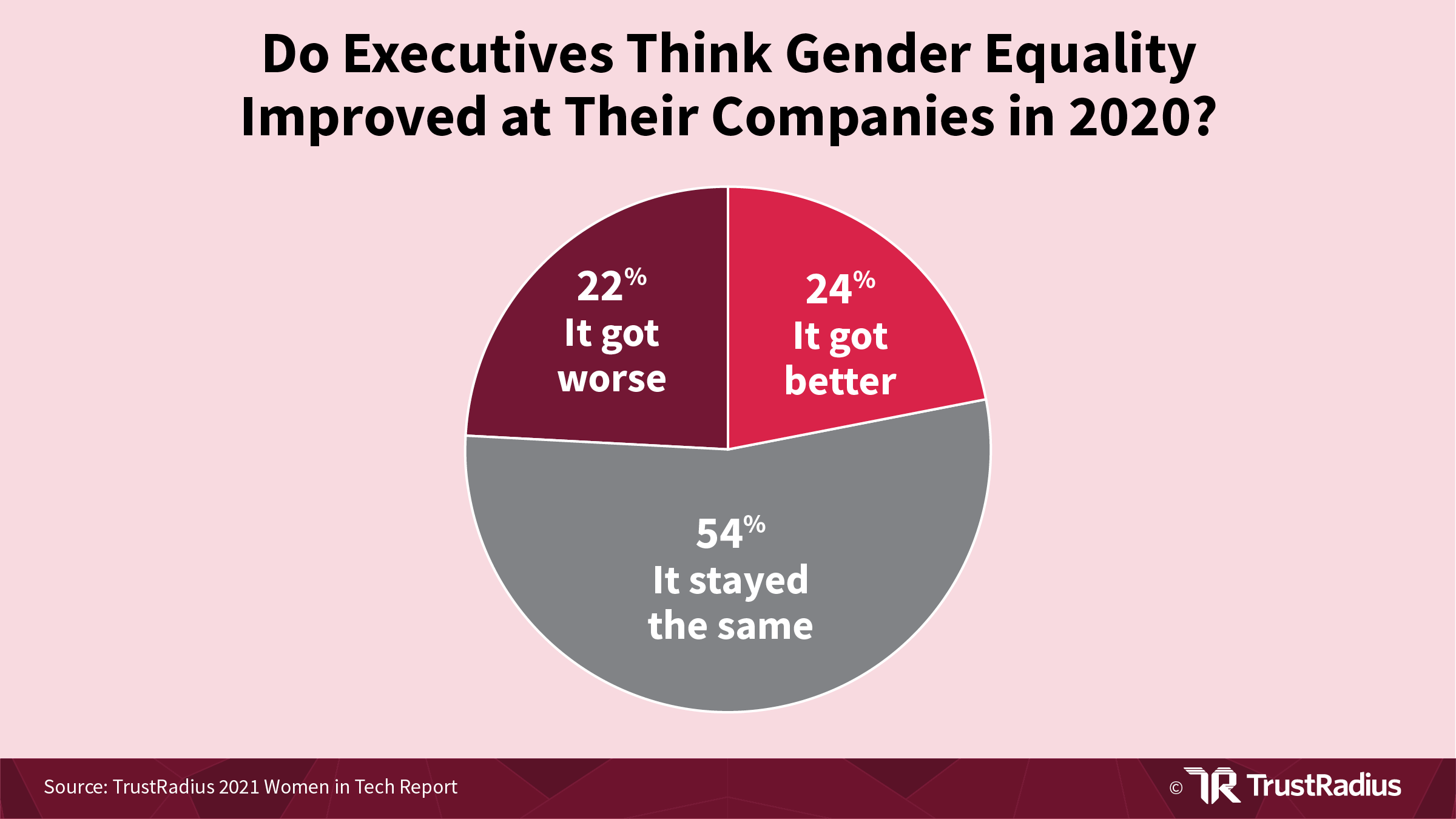
Weber Shandwick research shows that C-level executives think we will reach gender equality in leadership by 2030. Despite this, 56% of those executives said their companies had no plan in place for doing so. It’s troubling when people who have the power to make change think progress will happen without taking action.
9. How Companies Should Support Women in Tech
Finally, we asked our community what companies should do to better support women and people of all gender identities in the tech industry. Here’s what they said:
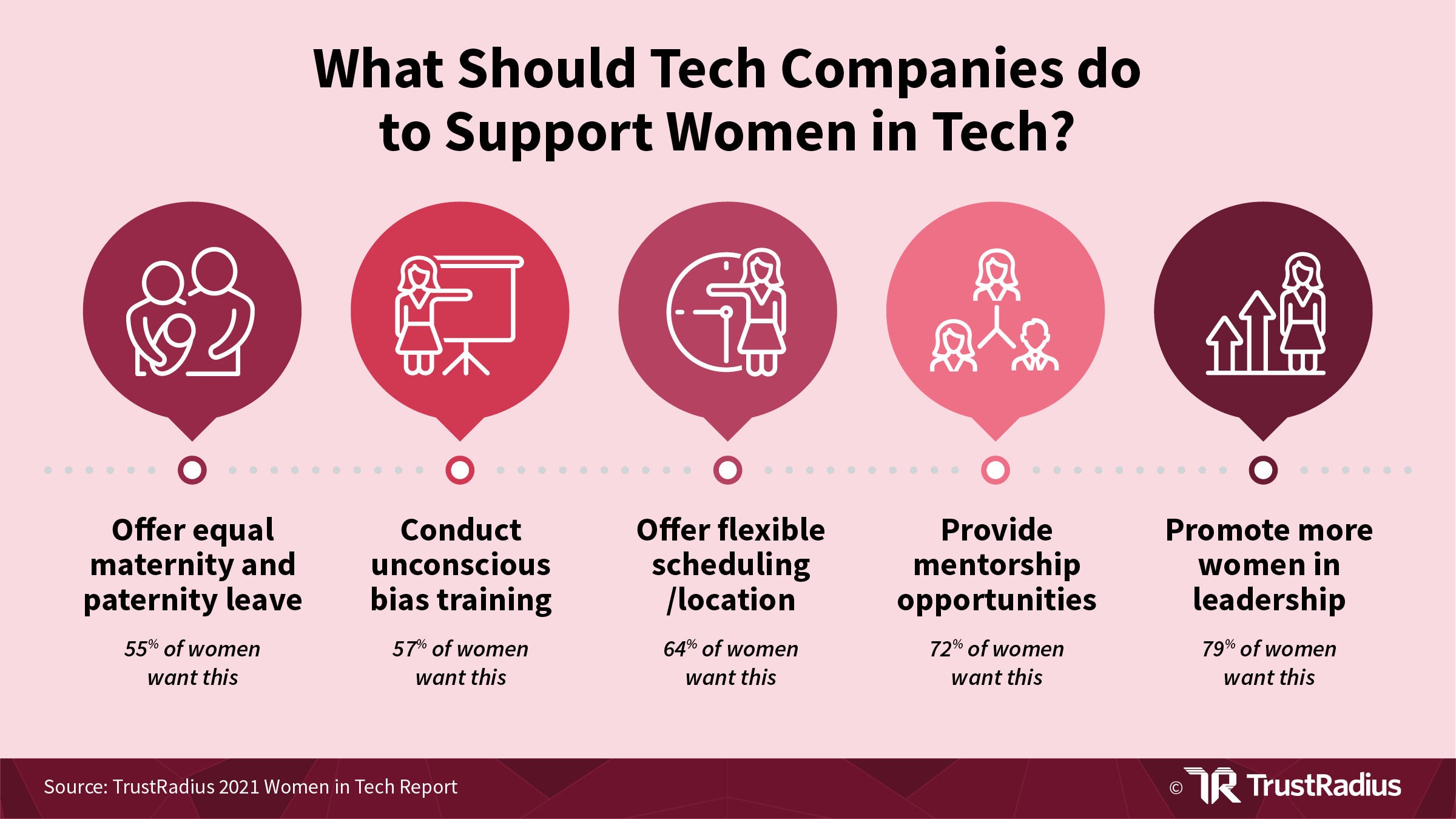
Looking for a good place to start? Check out the following resources:
- This Gender Gap Analysis Tool from the UN will help you discover pay disparities.
- This collection of essays by Silicon Valley tech women makes the problem more human.
- This Stanford research study shows where well-meaning executives go astray.
In Their Own Words
Our survey respondents had a lot to say about how companies should address these issues. We will end this report with their words. Let this be a guide for all of us as we work toward a more equal future.
Women in Leadership
“Companies should provide more leadership opportunities for women. In most African tech companies, leadership roles in Software Engineering and Project Management are mainly reserved for men. Allocating these roles to women will create more creativity, trust, and innovation in the industry.”
— Godwin Arigbonu, Director of Marketing at Thriveonus Limited
Mentorship and Coaching
“Provide mentorship programs!”
—Declan McGarrigle, Programme Manager at Kinaxis
“Companies should encourage and mentor women and non-binary people in IT Career Education programs. Currently my applicant pool is 100% male.”
—Randy Kouns, Director of Information Technology for the City of Richmond, Indiana
Flexible Working Conditions
“Flexibility is key, especially in this environment. I’m appalled by how many women have had to drop out of the workforce because of family circumstances brought on by the pandemic. Some of the most creative firms in the world are in tech; we need them to care as much about innovating on the model of work as they do about innovating in product.”
— Leela Srinivasan, Chief Marketing Officer at SurveyMonkey
Unconscious Bias
“We must train all colleagues on unconscious bias, regardless of their gender, age or level of seniority”
— Anonymous, Manager in Marketing
“A key is to recognize that bias is often unintentional and address it head on. Review promotions and salaries to ensure that women aren’t being left behind.”
— Kellyn Gorman, Sr. Azure Data Engineer at Microsoft
Maternity and Paternity Leave
“Companies should prioritize equal pay and parental leave as they play an essential role in setting the foundation for fairness”
— Barbara Houdayer, Chief Marketing Officer at Gmelius
“Offer paid parental leave. Provide a mentorship track and more leadership opportunities.”
— Sandy Miranda, Chief Customer Officer at PowerDMS
Equal and Transparent Pay
“We want transparent pay bands for salaries shared at EVERY level including VP, SVP.”
— Mary J Miller, Director, Enterprise Globalization, Programs and Operations at Indeed
Methodology and Demographics
Standard rounding rules have been applied to all percentages shown in charts above. Answers selected by a half percent of respondents or more were rounded up. This was applied consistently, even where it led to the appearance of a total response greater than 100%.
| Gender Identity | Count |
| Woman | 300 |
| Man | 149 |
| Non-Binary | 7 |
| Grand Total | 456 |
| Age | Count |
| 24 or younger | 12 |
| 25-40 | 265 |
| 41-56 | 143 |
| 57-75 | 36 |
| Grand Total | 456 |
| Job Title | Count |
| Entry Level | 56 |
| Manager | 183 |
| Director | 80 |
| Vice President or C-Suite | 42 |
| CEO, Owner, or Founder | 21 |
| Other (please specify) | 74 |
| Grand Total | 456 |
| Department | Count |
| Customer Service | 23 |
| Engineering and IT | 171 |
| Finance and Accounting | 8 |
| Human Resources | 15 |
| Marketing | 108 |
| Other (please specify) | 52 |
| R&D | 21 |
| Sales | 58 |
| Grand Total | 456 |
| Race and/or Ethnicity | Count |
| White or Caucasian | 305 |
| Asian | 85 |
| Latino | 36 |
| Other | 24 |
| Black or African American | 18 |
| American Indian or Alaska Native | 8 |
| Native Hawaiian or other Pacific Islander | 3 |
Looking For More Data on Women in Tech?
We’ve been researching women in tech for three years running.
Check out previous reports from TrustRadius for more statistics and insights:
Was this helpful?
